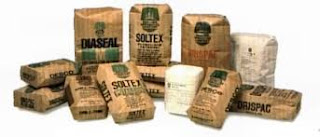 |
| Cementing Additive Chemical |
Additional chemicals are used to control slurry density, rheology, and fluid loss, or to provide
more specialized slurry properties. Additives modify the behavior of the cement slurry allowing cement placement under a wide range of downhole conditions. There are many additives available for cement and these can be classified under one of the following categories:
Accelerators: Most operators wait for cement to reach a minimum compressive strength of 500 psi before resuming operations. At temperatures below l00 °F common cement may require a day or two to develop this strength level. chemicals which reduce the thickening time of a slurry and increase the rate of early strength development. Low concentrations of cement accelerators (2-4% by weight of cement) are used to shorten the setting time of cement and promote rapid strength development.They are usually use in conductor and surface casing to reduce waiting on cement time (WOC). Calcium chloride (CaCl2), sodium chloride (NaCl) and sea water are commonly used as accelerators.
Retarders: chemicals which retard the setting time (extend the thickening) of a slurry to aid cement placement before it hardens. Retarders Increased well depths and formation temperatures require the use of cement retarders to extend the pumpability of cements. Most retarders also affect cement viscosity to some extent..These additives are usually added to counter the effects of high temperature.They are used in cement slurries for intermediate and production casings, squeeze and cement plugs and high temperature wells. Typical retarders include: sugar; lignosulphonates, hydroxycarboxylic acids, inorganic compounds and cellulose derivatives.
Retarders work mainly by adsorption on the cement surface to inhibit contact with water and
elongate the hydration process; although there are other chemical mechanisms involved.
Lignosulfonates are used to about 200°F bottom-hole circulating temperature (BHCT). Concentrations of 0.1% to 1% are used in most slurry applications to give both predictable thickening times and compressive strength.
Organic acids can be used from about 200°-400°F BHCT. They are used on concentrations of 0.1% to 2.5% by weight of cement as effective retarders for high temperature environments.
Extenders: materials which lower the slurry density and increase the yield to allow weak
formations to be cemented without being fractured by the cement cloumn.Examples of
extenders include: water, bentonite, sodium silicates, pozzlans, gilsonite, expanded perlite,
nitrogen and ceramic microspheres. Bentonite clay can be used in concentrations up to 25%
by weight of Portland cement to decrease the density.
Weighting Agents (density adjusters): materials which increase slurry density including barite and haematite High-density slurries are used to cement high-pressure wells where increased hydrostatic head is required to hold down gas or fluids.
- Hematite, sp. gr. of 5, is used to increase slurry density to 21 1b/gal. Barite, sp. gr. 4.2 can
increase slurry weight to 18Ib/gal.
- Sand, sp.gr. 2.65, has a low water requirement and helps to densify slurries to 17.5Ib/gal.
Dispersants: chemicals which lower the slurry viscosity and may also increase free water by dispersing the solids in the cement slurry. Dispersants are solutions of negatively charged polymer molecules that attach themselves to the positively charges sites of the hydrating cement grains.The result is an increased negative on the hydrating cement grains resulting in greater repulsive forces and particle dispersion.
The most common dispersants are aryl-alkyl sulphonates used in concentrations of 0.3% to 2% by weight of cement polyphosphate, lignosulfonate, salt and organic acid.
Fluid-Loss Additives: Excessive fluid losses from the cement slurry to the formation can affect the correct setting of cement. Fluid loss additives are used to prevent slurry dehydration and reduce fluid loss to the formation.Examples include: cationic polymer, nonionic synthetic polymer, anionic synthetic polymer and cellulose derivative.
Lost Circulation Control Agents: materials which control the loss of cement slurry to weak or fractured formations.
Strength Retrogression: At temperatures above 230 F, normal cement develop high permeability and reduction in strength. the addition of 30-40% BWOC (by weight of cement) silica flour prevents both strength reduction and development of permeability at high temperatures.
Miscellaneous Agents: e.g. Anti-foam agents, fibres, latex.
No comments:
Post a Comment